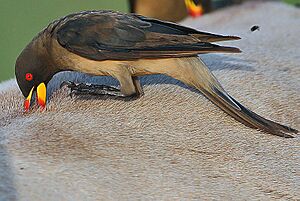Yellow-billed oxpecker facts for kids
Quick facts for kids Yellow-billed oxpecker |
|
|---|---|
 |
|
| Adult in typical feeding mode | |
 |
|
| On a zebra, Senegal | |
| Conservation status | |
| Scientific classification | |
| Genus: |
Buphagus
|
| Species: |
africanus
|
 |
|
| Range of the yellow-billed oxpecker | |
| Synonyms | |
|
Buphaga africana Linnaeus, 1766 |
|
The yellow-billed oxpecker (Buphagus africanus) is a special type of bird found in Africa. It belongs to the family Buphagidae, but it used to be grouped with starlings and myna birds.
These birds live in the savannahs and grasslands of Sub-Saharan Africa. You can find them from Senegal in the west all the way to Sudan in the east. They are not as common in the far eastern parts of their home range, where they share space with the red-billed oxpecker.
Contents
About the Yellow-Billed Oxpecker
The yellow-billed oxpecker is about 20 centimeters (8 inches) long. It has a plain brown body and head, with a lighter, buff-colored belly and a pale rump (the area above its tail). Its feet are strong, which helps it hold onto large animals.
Adult oxpeckers have a unique bill that is yellow at the bottom and red at the tip. Young oxpeckers, called juveniles, have brown bills. When they fly, their flight is strong and goes in a straight line. Their call sounds like a hissy, crackling "krisss, krisss."
What Do Oxpeckers Eat?
Yellow-billed oxpeckers are famous for what they eat! They mostly feed on insects and ticks that they find on large wild and farm mammals. This is how they got their English name, "oxpecker," because they peck at oxen (cattle). They also perch on other animals like wildebeest.
These birds are very good at finding parasites. An adult oxpecker can eat more than 100 ticks in a single day! They also eat tiny tick larvae, sometimes as many as 13,000 in a day.
Interestingly, oxpeckers also like to feed on blood. While they might eat ticks that are full of blood, they can also peck at small wounds on the animals to get blood directly. Even though this happens, the large mammals usually don't seem to mind the oxpeckers. It's like a partnership where the birds get food, and the animals get some parasites removed.
Reproduction and Life Cycle
Yellow-billed oxpeckers build their nests in holes found in trees. They line these nests with hair that they pull from livestock animals. A female oxpecker usually lays 2 to 3 eggs at a time.
When it's not the breeding season, these birds often gather in large, noisy flocks. At night, birds that are not breeding will even sleep on the host animals they feed on during the day.
Scientific Classification
The scientific name for the yellow-billed oxpecker is Buphagus africanus. This name helps scientists around the world know exactly which bird they are talking about. The genus name Buphagus was first used by a French zoologist named Mathurin Jacques Brisson. Later, in 1766, the famous Swedish scientist Carl Linnaeus officially gave the bird its full scientific name.
There are two main types, or subspecies, of the yellow-billed oxpecker:
- B. a. subsp. africanus – This type is found from Mauritania and Senegal all the way to northwest Ethiopia and south to northeast South Africa.
- B. a. subsp. langi – This type lives in Gabon, Congo, the Democratic Republic of the Congo, and western Angola.


